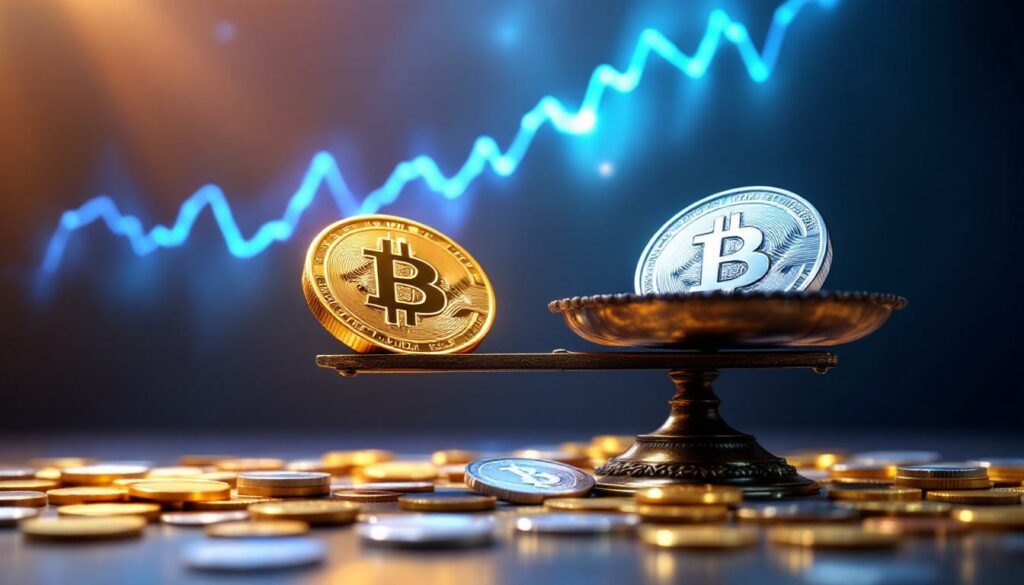Understanding the Gold-Silver Ratio: Historical Patterns, Trading Strategies, and Market Implications
The gold-silver ratio represents how many ounces of silver it takes to purchase one ounce of gold. This key metric has been used by traders, investors, and analysts for centuries to determine relative value between the two precious metals and identify potential trading opportunities.
How the Ratio Is Calculated
The gold-silver ratio is calculated through simple division: the price of gold per ounce divided by the silver price per ounce. As of June 2025, this ratio stands at approximately 90:1, meaning it takes 90 ounces of silver to purchase one ounce of gold.
This current ratio stands significantly higher than the historical average of roughly 50:1 over the past century. Even more striking is the contrast with the natural geological ratio found in Earth's crust, which is approximately 17:1—suggesting silver may be undervalued compared to its natural abundance. For a deeper understanding, gold-silver ratio insights offer additional perspectives on this valuation gap.
Historical Significance of the Ratio
The gold-silver ratio has witnessed dramatic fluctuations throughout history, serving as a barometer for relative value between these precious metals:
- Ancient civilizations: Often maintained at 12:1 to 15:1
- U.S. Coinage Act of 1792: Officially set at 15:1
- Modern era extremes: From below 20:1 (1980) to above 120:1 (2020)
- Recent decade average: Approximately 70:1
Andrew Maguire, a precious metals expert, emphasizes that "the gold-silver ratio trade is now actively in the process of harvesting asymmetrically imbalanced short bets against silver," indicating that the current ratio may be poised for significant change.
How Has the Gold-Silver Ratio Evolved Over Time?
The relationship between gold and silver prices has undergone significant transformations through different market cycles and monetary systems, reflecting changing industrial uses, investment patterns, and monetary policies.
Key Historical Inflection Points
Pre-20th Century: When both metals served as monetary standards, governments often fixed the ratio to stabilize their currencies. These fixed ratios generally reflected the metals' relative scarcity and extraction costs at the time.
1970s Silver Bull Market: The ratio compressed to near 20:1 during the Hunt brothers' silver accumulation attempt, demonstrating how concentrated buying pressure can dramatically affect the ratio.
2011 Peak: The ratio dropped to 35:1 when silver approached $50/oz during the post-financial crisis precious metals bull market, driven by both investment and industrial demand.
2020 Pandemic High: The ratio expanded to an unprecedented 120:1 before rapidly contracting to 70:1 in just five months—one of the fastest ratio contractions in modern history. This volatile period has been examined extensively in gold price forecast analyses.
Current Trend (2025): Silver has broken a 14-year resistance level at $35, triggering short squeezes and suggesting the start of a significant mean reversion from historically high levels.
What Drives Ratio Changes?
Multiple factors influence the relationship between gold and silver prices:
- Industrial demand shifts: Unlike gold, silver has substantial industrial applications, making its price more sensitive to economic activity
- Investment flows: Institutional positioning can significantly impact the ratio, with recent data showing bullion banks shifting to long silver positions
- Central bank policies: While central banks hold gold reserves, they maintain minimal silver holdings, creating asymmetric official sector impacts
- Mining production dynamics: Approximately 50% of silver is produced as a byproduct of other metal mining, creating supply constraints when base metal production declines
- Market sentiment: Risk perception shifts can cause investors to favor one metal over the other
According to Andrew Maguire, "Silver [is] evidencing strong Chinese and Asian demand," with "supply shortages [that are] impossible to hide," suggesting fundamental support for ratio compression.
Why Is the Current Gold-Silver Ratio Considered Unsustainable?
At approximately 90:1, today's gold-silver ratio sits well above historical norms, suggesting potential for significant reversion based on both technical and fundamental factors.
Market Structural Factors
Physical supply shortages in silver have become increasingly evident, with ETF inflows reaching 690 tons over just four weeks in mid-2025. This demand surge strains an already tight physical market, potentially leading to a silver market squeeze with global financial implications.
A crucial shift has occurred in institutional positioning, with bullion banks moving from short to long positions in their proprietary trading books—a significant reversal of their historical stance.
Industrial demand continues growing, particularly in green energy technologies and electronics, with solar panel manufacturing consuming an increasing percentage of annual silver production. Unlike gold, industrial silver is rarely recycled, leading to permanent supply removal.
Mining production constraints remain significant, as silver is primarily produced as a byproduct of base metal mining, limiting producers' ability to increase output in response to higher prices.
Expert Analysis on Ratio Extremes
Market analysts highlight several factors suggesting the current ratio is unsustainable:
"The natural ratio should be 10:1… an interim gap close to 35:1 is realistic," notes Andrew Maguire, pointing to the geological abundance and historical trading ranges.
Basel III banking regulations have created asymmetric treatment between gold and silver, with allocated gold being compliant while unallocated silver faces leverage restrictions. This regulatory imbalance puts additional pressure on institutions carrying large silver short positions.
The "synthetic silver leverage is implausible" under new banking rules, according to market experts, with claims that unallocated silver markets may have operated with leverage ratios approaching 500:1—a situation that becomes increasingly difficult to maintain as physical delivery demands rise. According to analyses from Macrotrends, such extreme leverage positions have historically preceded major market adjustments.
What Trading Strategies Utilize the Gold-Silver Ratio?
Investors and traders have developed various approaches to capitalize on movements in the gold-silver ratio, ranging from simple allocation adjustments to sophisticated pair trading strategies.
Ratio Trading Fundamentals
Pair Trading: This strategy involves simultaneously selling the overvalued metal while buying the undervalued one. In the current environment with a ratio of 90:1, this would typically mean selling gold and buying silver with the proceeds.
Rebalancing Strategy: A more conservative approach involves converting portions of holdings when the ratio reaches extreme levels. For example, converting 20% of gold holdings to silver when the ratio exceeds 80:1.
Trend Following: Some traders prefer trading in the direction of the ratio's momentum, particularly during periods of rapid change like the 2020 swing from 125:1 to 70:1 in just five months.
Mean Reversion: This approach anticipates a return to historical averages or significant support/resistance levels, with positions sized according to deviation from the mean.
Practical Implementation Examples
-
High Ratio Environment (90:1+):
- Convert some gold holdings to silver
- Increase silver allocation in new purchases
- Consider silver mining equities over physical metal for leverage
- Target interim ratio of 50:1 for partial profit-taking
-
Medium Ratio Environment (50-70:1):
- Maintain balanced positions
- Focus on individual metal fundamentals rather than ratio
- Monitor technical indicators for directional shifts
- Consider options strategies to capitalize on volatility
-
Low Ratio Environment (Below 40:1):
- Consider converting silver to gold
- Reduce exposure to silver mining equities
- Increase gold allocation in new purchases
- Implement trailing stops to protect silver gains
Andrew Maguire advises that in the current environment, "dips will be shallow" as silver is "bid-only," suggesting aggressive buying of pullbacks may be warranted. His targets include "$50 after $40 support" is established.
Disclaimer: The trading strategies discussed are for educational purposes only. Past performance does not guarantee future results. Consider consulting a financial advisor before implementing any investment strategy.
How Do Institutional Players Influence the Gold-Silver Ratio?
Large financial institutions and central banks play a significant role in shaping the relationship between gold and silver prices, often driving major ratio shifts through their positioning and public guidance.
Bullion Bank Positioning
Historically, major bullion banks maintained short positions in silver futures as part of their market-making activities. However, a significant shift occurred in 2025, with institutions like Goldman Sachs not only closing short positions but actively establishing long positions.
This institutional reversal creates a "short squeeze" potential, as remaining short positions face pressure to cover in a rising price environment. The transcript notes that Goldman Sachs began advocating long silver positions to clients in April 2025, marking a public acknowledgment of this positioning shift.
Market dynamics have been further influenced by the implementation of Basel III banking regulations, which impose stricter capital requirements on unallocated precious metals positions. This regulatory pressure incentivizes banks to reduce synthetic positions and increase allocated holdings.
Seasonal demand patterns also influence institutional positioning, with banks typically adjusting inventory ahead of known demand cycles in jewelry manufacturing and industrial consumption.
Central Bank Influence
Central banks globally have been active gold purchasers, adding to official reserves while maintaining minimal silver holdings. This asymmetric approach creates different supply-demand dynamics for the two metals, contributing to the current record gold prices analysis we're seeing in the market.
Monetary policy decisions impact precious metals broadly, with accommodative policies generally supporting both metals but often benefiting gold more directly as an alternative to fiat currencies.
The ABAX contract launched on June 12, 2025, represents a new Basel III-compliant exchange mechanism that could alter institutional trading patterns by providing a deliverable alternative to traditional unallocated trading.
According to industry experts, "The LBMA cartel is starved of supply to maintain unallocated silver," while "China's buying is forcing deliverable pricing" in international markets, suggesting a fundamental shift in price discovery mechanisms.
What Technical Indicators Signal Ratio Reversals?
Traders use various technical analysis tools to identify potential turning points in the gold-silver ratio, with certain patterns and indicators proving particularly valuable at historical inflection points.
Key Technical Signals
Multi-year Resistance/Support Levels: Historical turning points around 80:1 and 40:1 have proven significant over decades. The recent breakout above a 14-year resistance level at $35 silver suggests a major technical shift is underway.
Moving Average Crossovers: The 50-day moving average crossing the 200-day often signals medium-term trend changes in the ratio. Current indicators show this "golden cross" pattern forming after years of the opposite "death cross" alignment.
Momentum Oscillators: RSI (Relative Strength Index) and MACD (Moving Average Convergence Divergence) divergences often precede major reversals. Current readings show silver's momentum accelerating while gold consolidates.
Volume Analysis: Unusual volume spikes frequently accompany ratio extremes. Recent data shows record volume in silver futures and ETF inflows, suggesting institutional participation is broadening.
Chart Patterns: Head and shoulders, double tops/bottoms often form at major turning points. The current silver chart shows a multi-year inverse head and shoulders pattern with a neckline at $35, now confirmed by price action.
Recent Technical Developments
The breaking of long-term resistance levels in silver has been accompanied by expanding contango in futures markets. According to market data, contango (the premium of future prices over spot) has widened to 12-14 cents at the $36-37 silver price level, indicating strong forward demand.
Increased volatility in ratio movements has coincided with a marked increase in options activity, particularly in out-of-the-money calls suggesting traders are positioning for continued silver strength.
Formation of potential reversal patterns on multiple timeframes reinforces the technical case for ratio compression, with weekly and monthly charts showing similar bullish structures.
Momentum indicators are suggesting exhaustion at extreme levels, with the weekly RSI breaking above 70 for the first time since 2011—a signal that preceded the previous move to a 35:1 ratio.
How Does Silver Outperformance Affect the Ratio?
When silver prices rise faster than gold, the ratio contracts, creating specific market dynamics and opportunities across various investment vehicles.
Catalysts for Silver Outperformance
Industrial demand growth has consistently exceeded supply increases, particularly in green energy technologies. Solar panel manufacturing alone now consumes a significant percentage of annual silver production, creating baseline demand independent of investment flows.
Investment demand has begun shifting from gold to silver for perceived value, evidenced by the 690-ton inflow to silver ETFs over just four weeks in mid-2025. This represents a substantial portion of annual mine production being absorbed by a single investment channel.
Supply constraints from reduced mining output persist, as low base metal prices have limited new mine development, and silver's role as a byproduct means production cannot quickly respond to higher silver prices.
Speculative positioning shifts in futures markets have accelerated, with commercial traders (traditionally short) reducing positions while managed money increases long exposure—a reversal of the pattern seen during the previous decade.
Market Behavior During Ratio Contractions
Periods of ratio contraction typically feature accelerated momentum as traders recognize the trend. The 2020 example saw the ratio compress from 125:1 to 70:1 in just five months, demonstrating how quickly sentiment can shift.
Increased volatility affects both metals during these periods, with silver typically experiencing larger percentage moves in both directions due to its smaller market size.
Mining company equities often outperform physical metals during ratio contractions, with silver miners in particular demonstrating operational leverage to rising prices. Companies with high silver production as a percentage of revenue tend to show the strongest correlation to ratio changes.
"Catch-up rallies" where silver rapidly gains on gold can create sudden market dislocations, particularly in derivatives markets where positioning may be imbalanced. The transcript mentions a "harvesting of asymmetrically imbalanced short bets against silver" currently underway.
What Role Do Physical Supply-Demand Fundamentals Play?
The physical markets for gold and silver ultimately drive long-term ratio trends despite short-term paper market fluctuations, with several unique factors influencing silver's supply dynamics.
Silver's Unique Supply Dynamics
Silver is primarily produced as a byproduct of other metal mining, with over 50% coming from lead, zinc, and copper operations. This creates an inelastic supply response to silver prices, as production decisions are driven by the economics of the primary metal.
Industrial consumption often results in permanent supply removal, unlike gold where approximately 85% of all metal ever mined remains in circulation. Silver used in electronics, photovoltaics, and medical applications is frequently uneconomical to recover.
Growing industrial applications continue to diversify silver's demand base, with emerging technologies in antibacterial coatings, 5G infrastructure, and electric vehicles adding to traditional uses in electronics and photography.
Limited above-ground inventories compared to gold create a tighter physical market. While central banks hold substantial gold reserves, they maintain minimal silver holdings, leaving the metal primarily in private hands and industrial inventories.
Physical Market Indicators
Premium/discount to spot prices in retail markets provide early warning signals of physical tightness. Current premiums on silver coins and small bars remain elevated, suggesting strong retail demand despite higher prices.
Delivery delays and product availability issues have been reported by major dealers, with some products backordered for weeks—a situation typically seen during periods of physical shortage.
Inventory levels in registered exchange warehouses have declined steadily, with COMEX eligible silver inventories showing consistent drawdowns as investors opt for physical delivery rather than rolling futures contracts.
Lease rates and backwardation/contango structures offer insights into immediate physical demand. The current contango in silver futures has widened to 12-14 cents at the $36-37 price level, indicating strong forward demand despite rising spot prices.
The new ABAX spot gold contract launched on June 12, 2025, represents an attempt to create more transparent price discovery for physically delivered metal, potentially influencing how the ratio trades by providing an alternative benchmark.
How Might the Gold-Silver Ratio Evolve in Coming Years?
Market experts and historical patterns suggest several possible scenarios for the future relationship between gold and silver prices, with most pointing toward significant ratio compression.
Potential Ratio Targets
Near-term target: 50:1 represents a return to the historical average over the past century and would require silver to outperform gold by approximately 80% from current levels.
Medium-term target: 35:1 would match the 2011 cycle low and represents a level where previous ratio compression moves have found support.
Long-term potential: 16:1 to 20:1 would reflect the natural abundance ratio of the metals in the Earth's crust and would require a fundamental revaluation of silver relative to gold.
According to Andrew Maguire, "$100 silver is realistic if gold stays underpriced," suggesting potential for the ratio to compress below 20:1 if gold remains near current levels. Understanding various gold investment strategies can help investors navigate these potential ratio changes.
Factors That Could Accelerate Ratio Compression
Continued industrial demand growth for silver, particularly in green energy technologies, creates a fundamental floor
Ready to Capitalise on the Next Precious Metals Opportunity?
Stay ahead of significant mineral discoveries and market opportunities with Discovery Alert's proprietary Discovery IQ model, which provides real-time notifications on ASX precious metal announcements and their potential impact. Visit our discoveries page to learn how major mineral discoveries have historically generated substantial returns for early investors.




